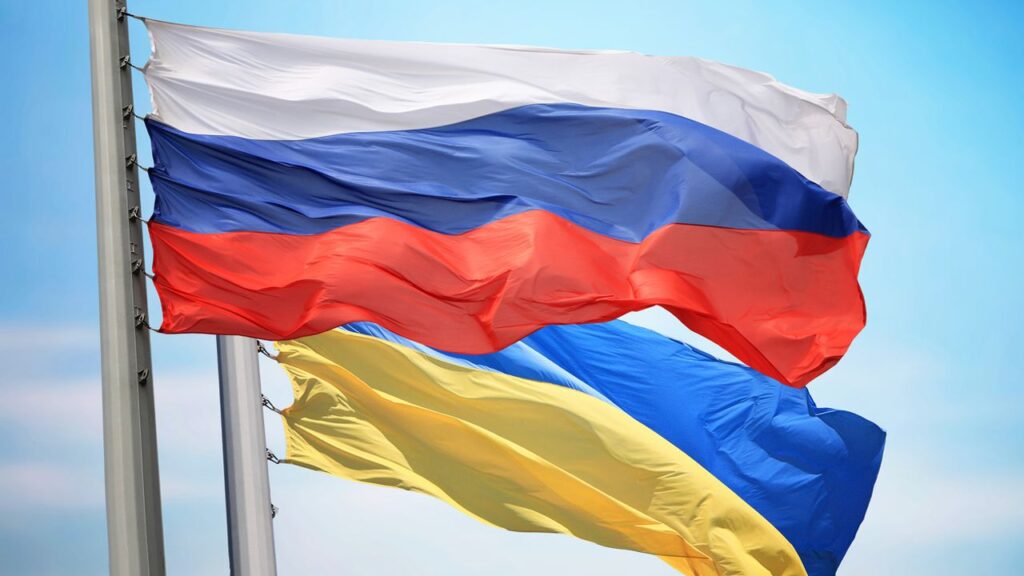Interviews / Observatoire géopolitique de l’espace post-soviétique
5 November 2025
War in Ukraine: Between Stalemate and Diplomatic Deadlock

As the prospect of a summit in Budapest has fallen through and the front lines remain unchanged, the Russo-Ukrainian conflict has become bogged down in a war of attrition—military as much as political. While Vladimir Putin still seems convinced that time is on his side, Volodymyr Zelensky is struggling to sustain the war effort. On the European side, the question of confiscating Russian assets or resorting to joint European borrowing has crystallised divisions across a continent torn between economic interests and political reputation, while Donald Trump’s approach appears increasingly self-serving. How should the current balance of power be interpreted, and what dynamics could redefine the course of the conflict? An analysis with Igor Delanoë, Associate Research Fellow at IRIS, specialising in Russian geopolitics.
Amid diplomatic posturing and cancelled meetings, recent developments show that a settlement to the conflict remains elusive. How can we analyse the strategies and goals of the main players in this war—Volodymyr Zelensky, Vladimir Putin and Donald Trump?
This cancellation is not surprising, as Russia’s positions have not changed since the Anchorage summit. Even though the Russian economy has entered a cooling phase, Vladimir Putin still likely believes that time works more in his favour than in Ukraine’s. Brussels is searching for funds to finance Ukraine’s 2026 budget—and could be tempted to confiscate 140 billion euros of frozen Russian assets held in Belgium for that purpose—while Kyiv continues to face major difficulties in renewing its military forces. These are challenges Moscow does not face to the same extent. Donald Trump, meanwhile, has backtracked on his previous stance—up to the Alaska summit—of demanding a ceasefire before the start of peace negotiations. This demand comes from the Ukrainians and the Europeans. Since they currently hold the strategic initiative and the battlefield dynamics are in their favour, the Russians are not interested in a ceasefire and insist on engaging directly in substantive talks while the fighting continues. This approach has historical precedent, seen in conflicts such as Korea and Vietnam—and was also the one adopted by the US President in Anchorage.
Vladimir Putin demands that Ukraine withdraw its forces from the 25% of the Donbas it still controls for Russian operations to be suspended. It appears that this demand was what led to the collapse of the Budapest summit. The issue mainly concerns the Kramatorsk–Sloviansk conurbation, which has been heavily fortified by Ukrainian forces since 2014. For the Kremlin, this represents both a military challenge—to avoid a battle expected to be even fiercer than that of Bakhmut—and a political one. Moscow cannot credibly claim victory while Ukrainian troops remain present in the Donbas. Moreover, the Russians know that such a withdrawal could spell political disaster for Volodymyr Zelensky. Therefore, freezing hostilities along the current line of contact holds little appeal for the Kremlin. A potential way forward might be to demilitarise and place that 25% under international administration. Both Russians and Ukrainians, it seems, could be open to that option.
As for Donald Trump’s new reversal, it should not be overinterpreted. The American president is now trying to twist the Russians’ arm—after having tried to do so with the Ukrainians—to secure an end to the fighting. He likely considers he has already recouped his costs, since the military equipment destined for Ukraine is now being funded by the Europeans, who have also agreed to invest massively in the US economy and in their own defence to ensure Washington does not turn its back on them. Trump’s only red line on the Ukrainian issue is the collapse of the government in Kyiv. The US president does not want Ukraine to become, for him, what Afghanistan’s withdrawal was for Joe Biden: a fiasco. He will therefore likely allow at least the continuation of US intelligence sharing with Kyiv and the support that enables Ukrainians to strike targets inside Russia.
While opinions were divided over the possibility of a meeting between Donald Trump and Vladimir Putin, a European plan now seems to be taking shape. What room for manoeuvre and influence do Europeans have in this diplomatic quagmire?
They are constrained by the financial and military resources available to Ukraine, against the backdrop of US disengagement. Politically, the EU’s room for manoeuvre is very limited, as the Europeans have severed communication channels with the Kremlin. They have placed themselves in a position of having to react to both Trump’s erratic moves and developments in Moscow–Washington relations. Reopening direct contact with Russia could increase their leverage—though there is no guarantee a dialogue would actually take place—but such willingness seems absent in Brussels. The 12-point plan aims to coordinate and clarify the positions of the European Union and Ukraine in this reactive logic, at a time when Washington’s stance on the Ukrainian issue is showing signs of fluctuation and reversal.
But the main issue remains the financing of Ukraine’s war effort by Brussels. The most tempting option—though politically and economically the riskiest—is the confiscation of 140 billion euros in assets from the Russian Central Bank frozen in Belgium with Euroclear. The Belgian government opposes this due to the likely negative repercussions: near-irreversible reputational damage among non-EU foreign investors, and lawsuits from European companies still holding assets in Russia, which would almost certainly be seized in retaliation by the Russian government. There are also concerns about the implications of such confiscation for the stability of the euro. As cutting off Ukraine’s funding is not an option for Europeans, the alternative lies in borrowing. Yet this scenario, too, fails to gain consensus among member states.
While the EU has adopted new sanctions against Russia, and Washington is preparing to strengthen its own, the governance of Vladimir Putin and his circle appears stable and unshaken. But is it really? Does Russia still have the means to continue its war?
Comparing various public opinion surveys conducted in Russia—whether loyal to the authorities or labelled as “foreign agents”—shows that Vladimir Putin and his actions continue to enjoy solid public trust. The government’s popularity, however, is starting to suffer from the economic slowdown, though nothing critical for now. Economically, Russia is expected to see sluggish growth this year—between 0.5% and 1%, well below the 4% to 4.5% of the past two years. Inflation, estimated at around 8–9%, remains high, and the Central Bank’s key interest rate—16.5% after its recent adjustment—stifles investment and credit. Russians are abandoning or postponing property projects due to prohibitive interest rates (over 20%). The low price of Russian oil—Urals crude having fallen almost continuously this year, below $60 in recent days—and an overly strong rouble against the dollar have reduced federal budget revenues, which had to be revised last autumn to account for this reality. Finally, the “sign-up bonuses” paid by regional authorities for contracts with the Russian Ministry of Defence have been drastically cut since the start of the academic year: depending on the region, they have been reduced by a factor of two, three, or even four.
That said, Moscow does not appear alarmed. Despite these real difficulties, it maintains its war effort and seems capable of sustaining it at the current level for the next two years. The country’s debt remains under control, with the debt-to-GDP ratio likely to reach around 20% by year-end, while the budget deficit should hover around 3% of GDP in 2025. The Kremlin views the economic sacrifices—significant as they are—as a cost still outweighed by the political and security stakes it perceives in this conflict.

